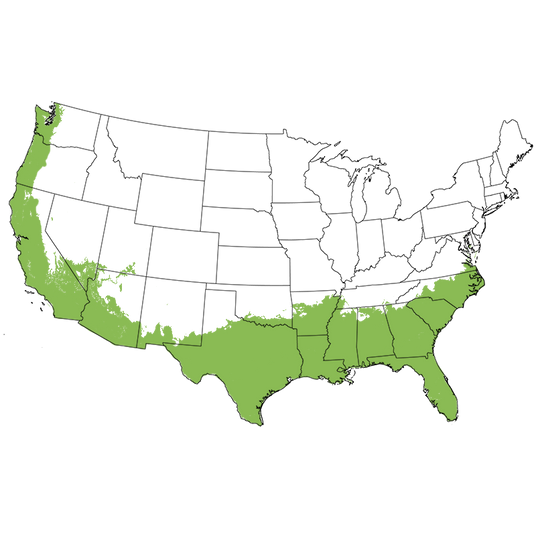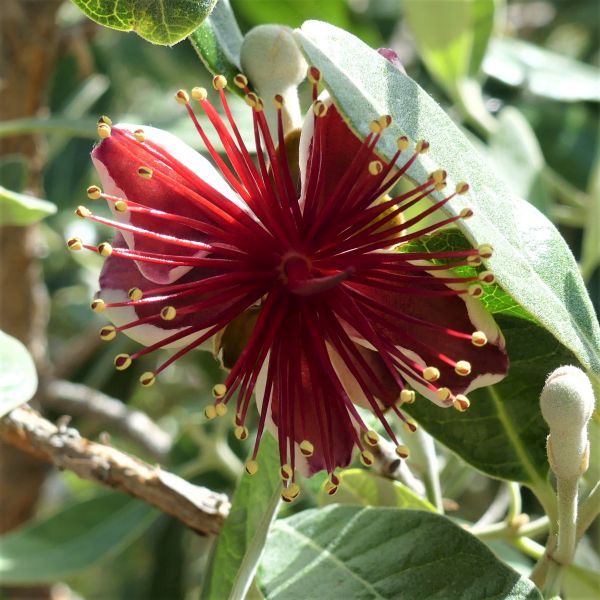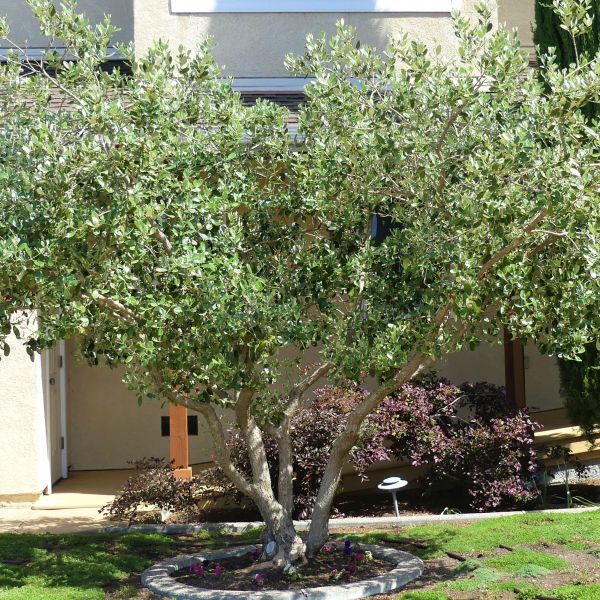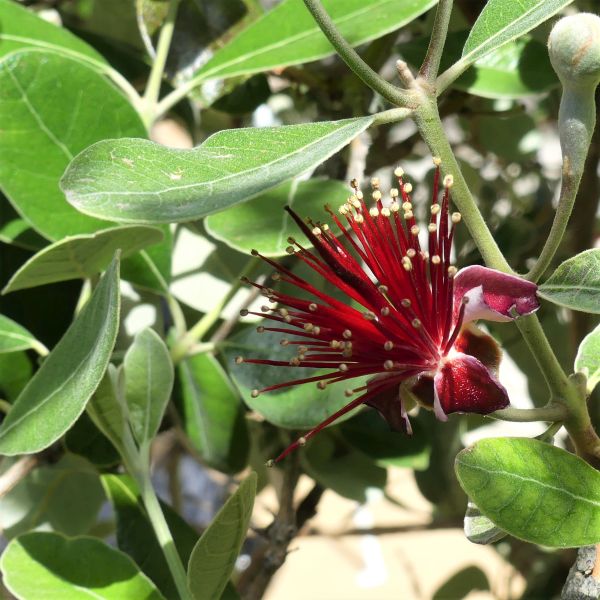Pineapple Guava Tree
Acca sellowiana
Plant Sentry™
Plant Sentry™

Plant Sentry™ Protected
Your order is protected by our compliance system that:
- Prevents restricted plants from shipping to your state
- Ensures plants meet your state's agricultural requirements
- Protects gardens from invasive pests and diseases
Delivery and Shipping
Delivery and Shipping
Delivery and Shipping
Fast, Safe Plant Delivery
Ships in 3-4 business days • Tracking provided • Weather protected
| Under $50 | $9.99 |
| $50 - $99.99 | $14.99 |
| $100 - $149.99 | $16.99 |
| $150 - $198.99 | $24.99 |
| $199+ | FREE |
✓ Zone-specific timing • ✓ Professional packaging • ✓ Health guarantee
Understanding Plant Options
Nature Hills offers plants in two main formats:
- Container Plants: Grown in pots with soil, sized by container volume and plant age
- Bare Root Plants: Dormant plants without soil, sized by height measurements
Container Plant Sizes
Container sizes indicate plant age and growing capacity rather than liquid volume equivalents. Our containers follow industry-standard nursery "trade gallon" specifications, which differ from standard liquid gallon measurements.
Young Plants (6 months to 18 months old)
| Container Size | Actual Volume | Metric Equivalent |
|---|---|---|
| 2" x 2" x 3" | 0.18 - 0.21 dry quarts | 0.20 - 0.23 dry liters |
| 4" Container | 0.31 - 0.87 dry quarts | 0.35 - 0.96 dry liters |
| 4.5" Container | 0.65 dry quarts | 0.72 dry liters |
| 6" Container | 1.4 dry quarts | 1.59 dry liters |
| 1 Quart | 1 dry quart | 1.1 dry liters |
| 5.5" Container | 1.89 dry quarts | 2.08 dry liters |
Established Plants (18 months to 2.5 years old)
| Container Size | Actual Volume | Metric Equivalent |
|---|---|---|
| 2 Quart | 2 dry quarts | 2.2 dry liters |
| #1 Container | 2.26 - 3.73 dry quarts | 2.49 - 4.11 dry liters |
| 5" x 5" x 12" | 3.5 - 4.3 dry quarts | 3.85 - 4.74 dry liters |
Mature Plants (2-4 years old)
| Container Size | Actual Volume | Metric Equivalent |
|---|---|---|
| #2 Container | 1.19 - 1.76 dry gallons | 5.24 - 7.75 dry liters |
| #3 Container | 2.15 - 2.76 dry gallons | 8.14 - 12.16 dry liters |
Large Plants (3-5 years old)
| Container Size | Actual Volume | Metric Equivalent |
|---|---|---|
| #5 Container | 2.92 - 4.62 dry gallons | 12.86 - 20.35 dry liters |
| #6 Container | 5.25 - 6.01 dry gallons | 23.12 - 26.42 dry liters |
| #7 Container | 5.98 - 6.53 dry gallons | 26.34 - 28.76 dry liters |
Bare Root Plants
Bare root plants are sold by height from the root system to the top of the plant. Plants may exceed minimum height requirements.
Common Sizes:
- Trees: 1 foot, 2 feet, 3 feet, 4 feet, 5 feet, 6 feet
- Shrubs & Perennials: 1 foot, 18 inches, 2 feet
Important Notes
Container Volume Specifications
- Trade Gallon Standard: Our containers follow industry-standard "trade gallon" specifications established by the American National Standards Institute (ANSI Z60.1) for nursery stock
- Volume Variations: Actual soil volume may vary due to plant root systems and growing medium settlement
- Age Indicators: Container size primarily indicates plant age and maturity rather than liquid volume equivalents
Growing Conditions
- Plant size can vary based on variety and growing conditions
- Container size helps indicate plant maturity and establishment level
- Larger containers generally mean more established root systems and faster landscape establishment
Seasonal Availability
- Bare root plants are available seasonally when dormant
- Container plants are available throughout the growing season
- Specific varieties may have limited availability in certain sizes
Questions?
For questions about specific plant sizes or availability, please contact our plant experts who can help you choose the right size for your landscape needs.

Plant Sentry™ Protected
Your order is protected by our compliance system that:
- Prevents restricted plants from shipping to your state
- Ensures plants meet your state's agricultural requirements
- Protects gardens from invasive pests and diseases
Plant Profile & Growing Essentials
Attracts Birds, Attracts Butterflies, Attracts pollinators, Clay Tolerant, Cold hardy, Container Friendly, Deer-resistant, Disease resistant, Drought resistant, Edible, Evergreen, Flowering, Fragrant, Full Sun, Heat Tolerant, Hedge/Screen, Low Maintenance, Non-invasive, Ornamental Berries/Fruit, Rabbit Resistant, Salt Tolerant, and Shade Tolerant
Specifications
Specifications
-
Botanical Name
-
Height
-
Width
-
Growing Zones
-
Sunlight
-
Growth RateModerate
-
Flower Color
-
Leaf Color
-
Pollinator FriendlyYes
-
Pollinator Required
-
Bloom PeriodLate Spring, Early Summer
-
Harvest Time
-
FragrantYes
Planting & Care Instructions
Planting & Care Instructions

Growing Zones 8-10
Pineapple Guava (Acca sellowiana (formerly known as Feijoa sellowiana)) is a versatile, easy-to-grow semi-tropical for zones 8-10 that is neither Pineapple nor Guava, but it is a showy plant with beautiful flowers that are tasty edible treats on their own! Followed by sweet Guava-like fruit! Beautiful ornamental landscaping plants on their own, the flowers and fruit are an aromatic addition to any recipe
The foliage is a typical Mediterranean gray-green, that's oval and leathery. All summer it is covered in exotic flowers that look like Guava blossoms. Only they are strikingly white and red and each petal is fleshy like a succulent.
Sprinkle the blooms that appear in early summer over salads and as garnish and decorating drinks. The fruit ripens in fall through winter and drops off the tree when ripe. The green rind and white interior bursts with incredibly aromatic scents and fruity tropical flavor. It's more banana-like than pineapple, and the texture is juicy and similar to a pear.
Planting and Application:
These large bushes can be trained and pruned to look like a small tree, or even can be trained as an Espalier, or kept shrubby and used as a hedge. It is an excellent specimen plant because of the lovely blooms that pollinators adore, and the juicy fruit for you! The smaller size can easily be maintained to accommodate any size property.
Prune smaller yet to maintain Pineapple Guava as a lovely container plant and place them around patios and poolside locations, anywhere regardless of the space available, even if you don't have an actual yard! Any frost-free sunny location is perfect for these tropical broadleaf evergreens!
- Beautiful Edible Flowers & Fruit
- Highly Aromatic Flowers & Fruit
- Beautiful Evergreen in Zones 8-10
- Fantastic Patio Plant, Container & Hedge
- Large Shrub & Small Tree With Pruning
#ProPlantTips for Care:
Preferring hot, dry weather to ripen, Pineapple Guava needs highly enriched soil with plenty of organic matter. Ensure your tree is planted in very well-drained soil because it will not tolerate soggy ground. Water well to establish, but then these are low moisture use shrubs once established. Provide a full sun location with good air circulation.
- Full Sun
- Highly Enriched Organic Soil
- Moderate Moisture
- Prune After Fruiting
- Drought-Tolerant Once Established
Add tropical edible beauty to your garden or patio this year with the aromatic and lovely Pineapple Guava Tree from NatureHills.com!
Useful and Delicious
A most unique variety of fruit and a valuable ornamental, the Feijoa sellowiana or Pineapple Guava as it is commonly known, has enjoyed an appreciation throughout the world for over 100 years.
A native to the extreme southern portion of Brazil and northern Argentina, Paraguay and Uruguay, the Feijoa grows wild in the mountain regions. The German botanist Otto Karl Berg first described the Feijoa sellowiana in 1859. The plant has been identified by two species names, Feijoa and Acca. These were combined in 1941, but few adapted the new species name Acca. It is still primarily referred to as Feijoa.
The plant has been shared throughout the world by renowned botanists and horticulturists since the mid to late 1800s. Arriving in Europe in the late 1860s, it was first grown by M. de Wette in Switzerland. The next reports are from the early 1890's, when renowned French botanist and horticulturist, Dr. Edouard Andre, brought air-layered plants from Brazil and planted them in his garden in France. The plants fruited in 1897.
More plantings for Feijoa continued during this time in Italy, France, Spain and arrived in New Zealand around the 1920s. There in New Zealand, the applicability of the Feijoa were explored and made popular. Today, Feijoa sellowiana/Acca sellowiana fruit is a valuable export from this country.
In 1901, seedlings were planted by Dr. F. Franceschi of Santa Barbara California in Santa Barbara. During this time, Dr. Franceschi also acquired plants that he sent to southern Florida. Unfortunately, those plants may have been planted incorrectly as the fruit was reported to fall to the ground before ripening. However, the Feijoa was finally tested and planted in northern Florida, where it does well.
Pineapple Guava can be pruned to any size, which means it works well as a hedge. The gray foliage works as a great background in the garden, and the fast growth and dense evergreen habit make it a perfect screen plant.
Feijoa sellowiana is a low to moderate water user and is recognized by the California Department of Water Resources, Water Use Classification of Landscape Species (WUCOLS) list. Once established, it only requires occasional additional summer water. This plant is recommended for all drought-tolerant and xeriscape landscapes.
Acca/Feijoa sellowiana is found on most fire-resistant landscape lists. In the landscape, it should be at least 10 feet from the house and never planted under taller trees. This plant is recommended for all defensible space plantings to support a fire-safe landscape.












